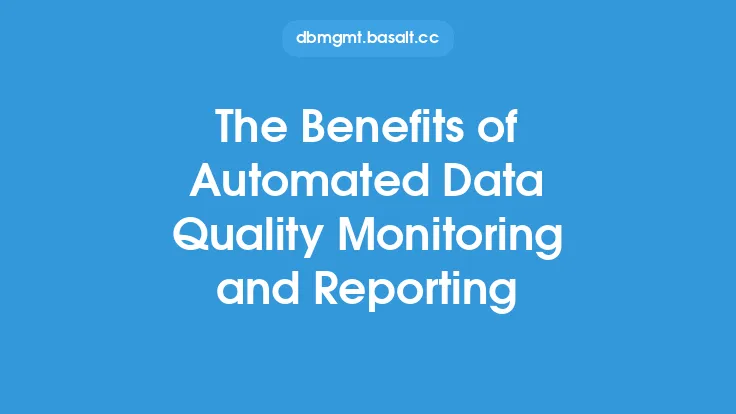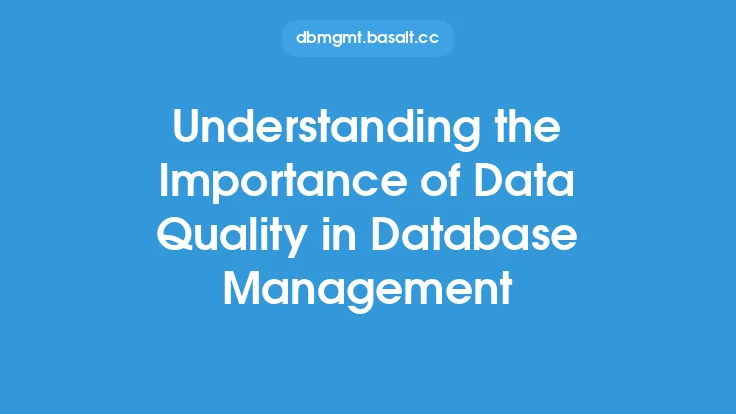Data quality is a critical aspect of any organization's data management strategy, and measuring its accuracy and reliability is essential to ensure that the data is trustworthy and usable. Data quality metrics provide a way to quantify the quality of data, allowing organizations to identify areas for improvement and track progress over time. In this article, we will explore the different types of data quality metrics, how to calculate them, and their importance in ensuring the accuracy and reliability of data.
Introduction to Data Quality Metrics
Data quality metrics are quantitative measures that assess the quality of data based on various dimensions such as accuracy, completeness, consistency, and timeliness. These metrics provide a way to evaluate the quality of data and identify areas that require improvement. There are several types of data quality metrics, including:
- Accuracy metrics: These metrics measure the degree to which data values are correct and consistent with the real-world values they represent.
- Completeness metrics: These metrics measure the degree to which data is complete and free from missing values.
- Consistency metrics: These metrics measure the degree to which data is consistent across different datasets and systems.
- Timeliness metrics: These metrics measure the degree to which data is up-to-date and reflects the current state of the business.
Types of Data Quality Metrics
There are several types of data quality metrics, each measuring a different aspect of data quality. Some of the most common types of data quality metrics include:
- Accuracy ratio: This metric measures the percentage of accurate data values in a dataset. It is calculated by dividing the number of accurate values by the total number of values and multiplying by 100.
- Error rate: This metric measures the percentage of incorrect data values in a dataset. It is calculated by dividing the number of incorrect values by the total number of values and multiplying by 100.
- Completeness ratio: This metric measures the percentage of complete data values in a dataset. It is calculated by dividing the number of complete values by the total number of values and multiplying by 100.
- Consistency ratio: This metric measures the percentage of consistent data values in a dataset. It is calculated by dividing the number of consistent values by the total number of values and multiplying by 100.
- Data freshness: This metric measures the age of the data, with newer data being considered fresher.
Calculating Data Quality Metrics
Calculating data quality metrics requires a thorough understanding of the data and the metrics being used. The following steps can be used to calculate data quality metrics:
- Define the metric: Clearly define the metric being used and the data it will be applied to.
- Collect the data: Collect the data required to calculate the metric.
- Clean and preprocess the data: Clean and preprocess the data to ensure it is accurate and consistent.
- Calculate the metric: Calculate the metric using the collected and preprocessed data.
- Interpret the results: Interpret the results of the metric calculation, identifying areas for improvement and tracking progress over time.
Importance of Data Quality Metrics
Data quality metrics are essential for ensuring the accuracy and reliability of data. They provide a way to quantify the quality of data, allowing organizations to identify areas for improvement and track progress over time. The importance of data quality metrics can be seen in the following ways:
- Improved decision-making: Data quality metrics help ensure that data is accurate and reliable, which is essential for making informed business decisions.
- Increased efficiency: Data quality metrics help identify areas for improvement, allowing organizations to streamline their data management processes and improve efficiency.
- Reduced risk: Data quality metrics help identify and mitigate risks associated with poor data quality, such as incorrect business decisions and non-compliance with regulatory requirements.
- Improved customer satisfaction: Data quality metrics help ensure that customer data is accurate and up-to-date, which is essential for providing excellent customer service.
Best Practices for Implementing Data Quality Metrics
Implementing data quality metrics requires a thorough understanding of the data and the metrics being used. The following best practices can be used to implement data quality metrics:
- Define clear goals and objectives: Clearly define the goals and objectives of the data quality metrics program.
- Choose the right metrics: Choose metrics that are relevant to the organization and the data being measured.
- Use automated tools: Use automated tools to collect and calculate data quality metrics.
- Monitor and track progress: Monitor and track progress over time, identifying areas for improvement and implementing changes as needed.
- Communicate results: Communicate the results of data quality metrics to stakeholders, providing insights and recommendations for improvement.
Technical Considerations
Implementing data quality metrics requires a thorough understanding of the technical aspects of data management. The following technical considerations should be taken into account:
- Data architecture: The data architecture should be designed to support the collection and calculation of data quality metrics.
- Data governance: A data governance framework should be established to ensure that data quality metrics are accurate and reliable.
- Data quality tools: Automated data quality tools should be used to collect and calculate data quality metrics.
- Data storage: Data should be stored in a way that supports the collection and calculation of data quality metrics.
- Data processing: Data should be processed in a way that supports the collection and calculation of data quality metrics.
Conclusion
Data quality metrics are essential for ensuring the accuracy and reliability of data. They provide a way to quantify the quality of data, allowing organizations to identify areas for improvement and track progress over time. By understanding the different types of data quality metrics, how to calculate them, and their importance in ensuring the accuracy and reliability of data, organizations can improve their data management processes and make informed business decisions.





